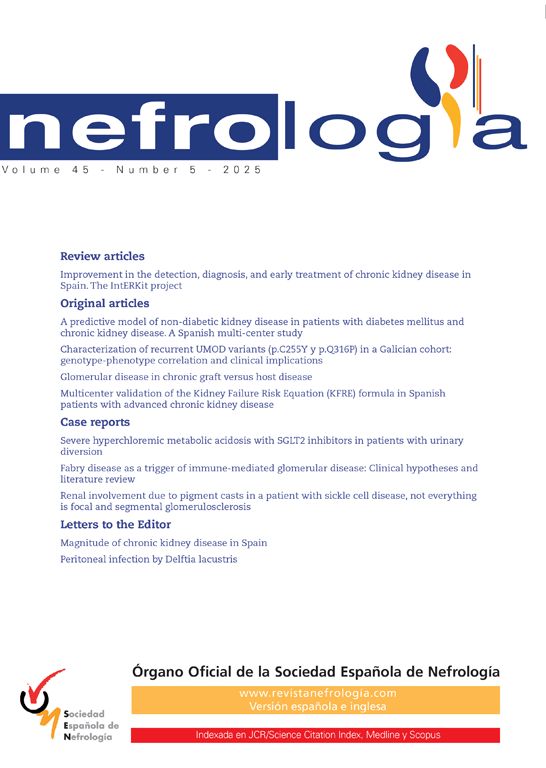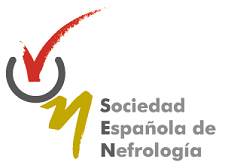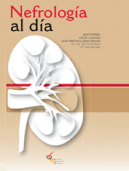Arterial hypertension (HTN) in pediatrics is a disease with an estimated prevalence between 2–4 %. Unlike in adults, the etiology is usually secondary, with the probability of finding an underlying disease being inversely proportional to the age of the child, and directly proportional to the maximum blood pressure figures. Among the secondary causes, the most frequent is renovascular disease, but the differential diagnosis includes multiple diagnostic entities, including monogenic/genetic causes of hypertension.1–3
We present a clinical case of monogenic HTN with onset in pediatric age.
Clinical caseA 7-year-old girl came to the emergency department because of severe and sudden headache with decreased level of consciousness, and elevated blood pressure for her age, height and sex (200/120 mmHg). Biochemical tests revealed hypokalemic metabolic alkalosis (pH 7.50; bicarbonate 30.4 mmol/l; sodium 143 mEq/l; potassium 1.7 mEq/l) with normal renal, and liver function and hemogram was normal. A cranial CT scan was performed due to neurological focality on examination which was normal. Labetalol perfusion and intravenous hydralazine boluses were started, requiring associated nitroprusside perfusion during the first 24 h.
An additional study was performed to determine the etiology of the hypertension. Abdominal ultrasound revealed moderate bilateral nephrocalcinosis with normal adrenal glands and patent renal arteries. Echocardiography showed left ventricular hypertrophy. Blood tests showed normal renal function, urine proteinuria (protein/creatinine ratio 10 mg/mg, albumin/creatinine ratio 1.088 mg/g) and hypercalciuria (calcium/creatinine ratio 0.48 mg/mg) and normal blood and urine cortisol.
Adequate evolution with progressive control of blood pressure with percentiles between p95-p99, oral treatment initiated 48 h after admission with amlodipine and atenolol. Due to suspicion of monogenic secondary HTN, amiloride/hydrochlorothiazide was added and a study was completed with a genetic panel aimed at monogenic HTN mutations. Prior to discharge, there were received results of suppressed plasma renin (<0.5 microlU/mL) with elevated aldosterone (257 ng/dl) compatible with hyporeninemic hyperaldosteronism for which reason amiloride/hydrochlorothiazide was replaced by spironolactone as the treatment of choice in these cases.
At discharge, blood pressure was controlled with spironolactone, atenolol and amlodipine. Subsequently, results of a genetic study were received confirming pathogenic mutation c.451 G > A; p(Gly151Arg) in the KCNJ5 gene compatible with familial primary hyperaldosteronism type III.
DiscussionRegardless of the genetic defect, in almost all presentations of monogenic HTN there is an increase in extracellular volume due to abnormal sodium reabsorption, with suppressed plasma renin activity.1,2
Familial hyperaldosteronism type 3 (PAH-III) is due to heterozygous mutations in the KCNJ5 gene (11q24), responsible for encoding the G protein-coupled inward rectifier potassium channel GIRK-4. These mutations result in less selective channels that allow the passage of sodium into the cell and depolarization of cells in the glomerular zone of the adrenal cortex leading to an increase in calcium at the intracellular level, inducing the expression of the aldosterone synthase gene (CYP11B2).1–3
At the clinical and biochemical level, it is remarkable a severe and treatment-resistant hypertension due to excessive sodium retention associated with hypokalemic metabolic alkalosis and suppressed plasma renin with elevated aldosterone,1–3 all of which were present in our patient. In patients with PAH-III, screening is performed by measuring the aldosterone/plasma renin ratio, which will be elevated due to increased aldosterone levels with suppressed renin.3
Aldosterone level plays an important role as a biochemical value that can guide us in the differential diagnosis of monogenic HTN, and is suppressed in cases of apparent excess of mineralcorticoids,4 deficiency of 11β-hydroxylase,5 deficiency of 17α-hydroxylase,5 glucocorticoid resistance,6 Geller syndrome, and Liddle's syndrome.1,2 However, in familial hyperaldosteronism (I-IV), aldosterone levels are elevated due to overexpression of the CYP11B2 gene.
The mainstay of treatment is based on the use of mineralocorticoid receptor antagonists (spironolactone or eplerenone) combined with potassium-sparing diuretics or drugs that decrease sodium channel activity (amiloride or triamterene).2,3 In our case, once renovascular hypertension with suppressed plasma renin and elevated aldosterone was ruled out, treatment was initiated with the combination of amiloride and hydrochlorothiazide as an antihypertensive drug, in addition to those previously mentioned in the clinical case. Amiloride is not used as a first-line treatment in patients with pediatric hypertension, but since we were awaiting the results of genetic studies and a monogenic cause was suspected, it was expected that one of the underlying mechanisms would be volume expansion due to increased sodium reabsorption, which is why it was initiated in combination with hydrochlorothiazide as a potassium-sparing agent. Once treatment has begun, in addition to achieving blood pressure control, laboratory parameters normalized, with resolution of metabolic alkalosis and normalization of potassium levels.
ConclusionsThis case illustrates how patients with early-onset hypertension, with severe hypertension, or drug-resistant hypertension, with a family history of refractory hypertension, acute cerebrovascular accident, or consanguinity, characteristic physical findings suggesting a specific syndrome, or fluid and electrolyte and acid-base imbalances, should be suspected of secondary hypertension of monogenic origin, even though it is a rare entity. While awaiting the results of genetic testing, the initiation of antihypertensive drugs that counteract the underlying mechanism (mineralocorticoid receptor antagonists or drugs that decrease sodium channel activity) can be considered.
FundingThis research has not received specific grants from public sector agencies, commercial sectors, or non-profit organizations.





